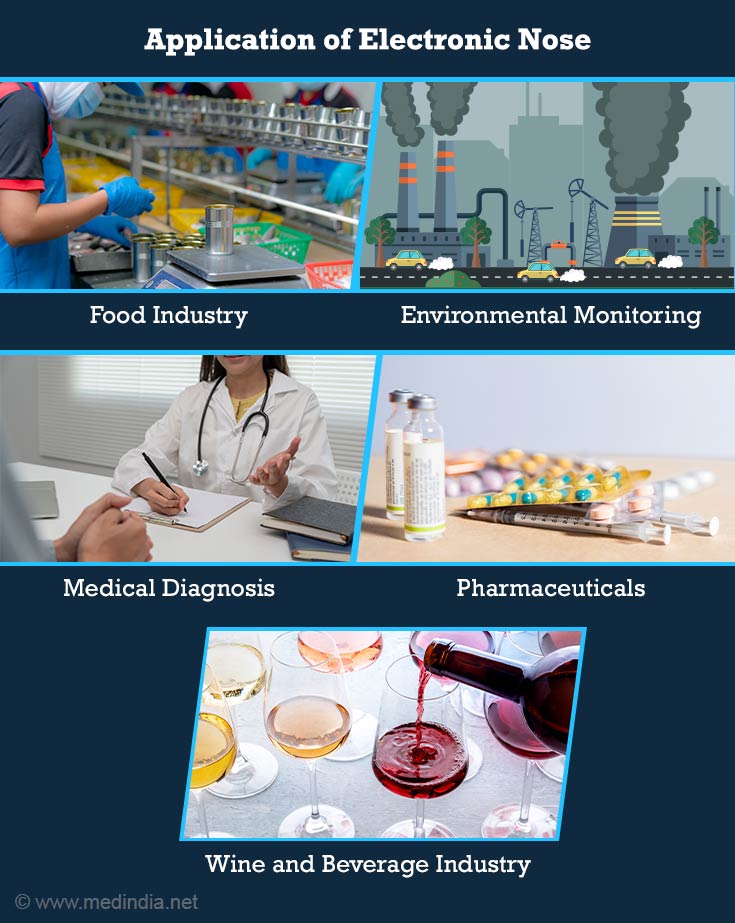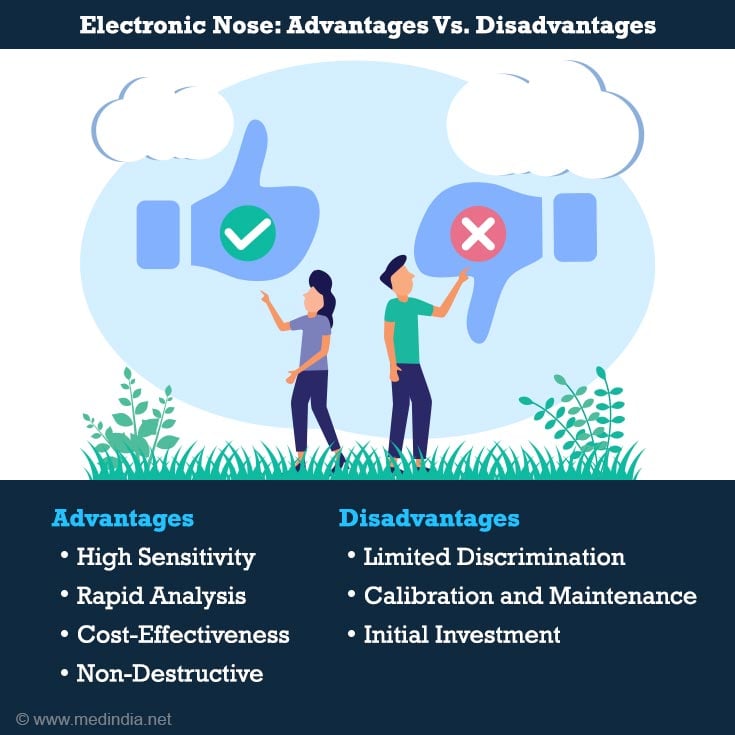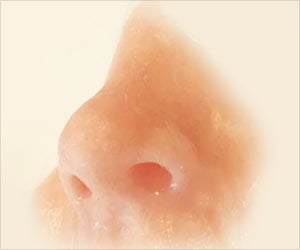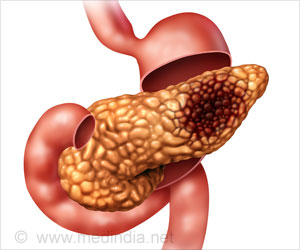- Applications and Advances in Electronic-Nose Technologies - (https://www.ncbi.nlm.nih.gov/pmc/articles/PMC3274163/)
- Recent Progress in Smart Electronic Nose Technologies Enabled with Machine Learning Methods - (https://www.ncbi.nlm.nih.gov/pmc/articles/PMC8619411/)
- Evaluation of IoT-Enabled Monitoring and Electronic Nose Spoilage Detection for Salmon Freshness During Cold Storage - (https://www.ncbi.nlm.nih.gov/pmc/articles/PMC7692724/)
- Electronic Noses in Medical Diagnostics - (https://pubmed.ncbi.nlm.nih.gov/28982314/)
- The strengths and weaknesses of the electronic nose - (https://pubmed.ncbi.nlm.nih.gov/11548160)
About
The Electronic Nose, often abbreviated as eNose, represents an advancement in sensory analysis technology. This intelligent device imitates the olfactory capabilities of humans, enabling it to detect and identify various odors or aromas, akin to our natural sense of smell. Through an array of sophisticated sensors, the eNose analyzes scents with remarkable precision.
The Electronic Nose has a wide range of applications, revolutionizing sensory analysis across industries. As research and development continue, we can expect even more sophisticated and versatile eNose devices in the future.
History of Electronic Nose
The inception of the Electronic Nose traces back to the mid-20th century, gaining substantial traction in the 1980s and 1990s. This surge in interest was propelled by significant strides in sensor technology and the emergence of artificial olfaction technology.
The term ’Electronic Nose’ was coined to encapsulate these cutting-edge devices. Since then, continuous research and development efforts have propelled the field forward.
Over the past 25 years, the research and advancement of electronic-nose applications in the biomedical field have seen remarkable progress(1✔ ✔Trusted Source
Applications and Advances in Electronic-Nose Technologies
Go to source).
Working Principle of Electronic Nose
At its core, the Electronic Nose operates on principles reminiscent of human olfaction. It leverages an array of sensors, each meticulously crafted to respond to distinct chemical compounds inherent in various odors.
These sensors produce a distinctive pattern of responses, effectively creating a 'fingerprint' for each scent. Through the application of machine learning algorithms, this pattern is cross-referenced against an extensive database of known scents, enabling the eNose to identify and categorize odors accurately(2✔ ✔Trusted Source
Recent Progress in Smart Electronic Nose Technologies Enabled with Machine Learning Methods
Go to source).
Understand Electronic Nose
Imagine you're a chef with an extraordinary palate for identifying different ingredients in a dish. You have a team of taste testers, each specialized in detecting specific flavors. For instance, one is excellent at picking out the freshness of herbs, another can pinpoint the sweetness of fruits, and so on. When you serve a new dish, each tester takes a bite and gives you feedback on the flavors they detected so that you can recreate the dish.
In the medical world, an electronic nose, or eNose, functions like your team of taste testers. It can detect specific odors associated with diseases, metabolic changes, and more. When a patient provides a sample, the eNose analyzes it and provides valuable information to healthcare providers. This helps in accurate diagnosis and monitoring, just like your taste testers help you recreate dishes.
Applications of Electronic Nose
The applications of Electronic Nose technology are diverse and continually expanding:
Food Industry:
In the food industry, eNoses serve as invaluable tools for quality control. They excel at detecting spoilage, monitoring freshness, and verifying the authenticity of ingredients, safeguarding the integrity of food products(3✔ ✔Trusted SourceEvaluation of IoT-Enabled Monitoring and Electronic Nose Spoilage Detection for Salmon Freshness During Cold Storage
Go to source).
Environmental Monitoring:
Electronic Noses are instrumental in environmental preservation efforts. They are deployed to detect pollutants and monitor air quality in both industrial and urban settings, contributing to a cleaner and safer environment.Medical Diagnosis:
The potential of Electronic Noses in medical diagnosis is immense. They exhibit promise in identifying specific diseases based on the unique odors associated with them, opening new avenues for early detection and intervention.
Pharmaceuticals:
Within the pharmaceutical industry, eNoses play a pivotal role in quality control during drug production. They are adept at detecting impurities or any deviations from standard formulations, ensuring the safety and efficacy of pharmaceutical products.Safety and Security:
In security settings, eNoses are indispensable for detecting hazardous or explosive materials. Their high sensitivity and rapid response time make them invaluable assets in safeguarding public spaces and critical infrastructure.Wine and Beverage Industry:
The eNose finds a niche in the evaluation of wines and other beverages. It excels in assessing their quality and characteristics, contributing to the refinement of production processes and the assurance of product excellence.Electronic Nose in Medicine
A plethora of applications for electronic noses has emerged across various healthcare sectors(4✔ ✔Trusted Source
Electronic Noses in Medical Diagnostics
Go to source).
These encompass the following:
Diagnostics:
eNoses can be used for early detection of diseases by analyzing the volatile organic compounds (VOCs) present in a patient's breath, urine, or other bodily fluids. For example, they can detect biomarkers associated with conditions like diabetes, certain cancers, and infections.Immunology:
In immunology, eNoses can be used to analyze the metabolic profile of pathogens or to identify specific immunological responses based on the VOCs emitted. This can aid in the development of diagnostic tools and monitoring of immune responses.Pathology:
eNoses can assist pathologists in identifying specific odors associated with different tissues or diseases. This could be particularly useful in the identification of certain types of cancer or infections.Patient Recovery:
eNoses can monitor the progress of patients during recovery by detecting changes in VOC patterns that may indicate complications or improvements. For example, they can help monitor wound healing after surgery.Pharmacology:
eNoses can be used to analyze the scent profiles of different medications, helping to ensure quality control and detect any potential issues with drug formulations.Physical Therapy:
In physical therapy, eNoses can be used to monitor the progress of patients with respiratory or metabolic conditions. They can assess changes in breath profiles during exercise or rehabilitation, helping therapists tailor treatment plans.Physiology:
eNoses can provide valuable information about the metabolic processes happening within the body. They can be used to study how different physiological states affect the composition of exhaled breath or other bodily fluids.Preventative Medicine:
eNoses can be employed for early screening and detection of diseases, allowing for timely intervention and preventive measures. For example, they can be used for early detection of infections or metabolic disorders.Remote Healthcare:
eNoses can be deployed in telemedicine settings, allowing for non-invasive monitoring of patients' health remotely. Patients can provide breath or fluid samples for analysis, which can be transmitted to healthcare providers for assessment.Wound and Graft Healing:
eNoses can assess the progress of wound healing by analyzing the VOCs emitted from the wound site. They can detect signs of infection or complications, helping healthcare providers make informed decisions about wound care.Electronic Nose and Respiratory Medicine:
In respiratory medicine, eNoses analyze breath prints - unique patterns of volatile compounds. They rapidly differentiate between conditions like asthma, COPD, and lung cancer. Used with other technologies, eNoses offer potential for personalized treatments and drug development.Laboratory Applications of eNose
Biochemical Testing:
Purpose: Biochemical testing using eNoses involves the analysis of volatile organic compounds (VOCs) in biological samples, such as breath, urine, or blood. This provides valuable information about the metabolic status and biochemical processes within the body.
Application: eNoses can be used for metabolic profiling, aiding in the diagnosis and monitoring of conditions like diabetes, liver disorders, and metabolic syndrome. For instance, they can detect specific VOC patterns associated with abnormal metabolic states.
Assessing Blood Compatibility
Purpose: Assessing blood compatibility is crucial in blood transfusions, organ transplantation, and other medical procedures. Compatibility testing ensures that donated blood or organs are compatible with the recipient's immune system.
Application: eNoses can analyze the scent profiles of blood samples to identify any anomalies that may indicate blood incompatibility. This can complement traditional blood typing methods and enhance safety in transfusion medicine.
Diagnosing Diseases
Purpose: eNoses have shown promise in diagnosing various diseases by detecting specific VOC signatures associated with different conditions. This non-invasive approach can lead to earlier and more accurate diagnoses.
Application: For example, eNoses can be used to detect lung cancer by analyzing breath samples for specific VOC markers. Similarly, they can aid in the diagnosis of infections, gastrointestinal disorders, and even certain types of cancer-based on distinct VOC patterns.
Facilitating Drug Delivery
Purpose: eNoses can play a role in optimizing drug delivery methods. By monitoring VOC profiles, they can help ensure that drugs are administered in the most effective and efficient manner.
Application: eNoses can be integrated into drug delivery systems to assess factors like absorption rates, dosage optimization, and drug release kinetics. This can be particularly valuable in personalized medicine, where tailored drug delivery is crucial.
Monitoring Metabolic Levels
Purpose: eNoses are used to monitor metabolic levels by analyzing the volatile organic compounds (VOCs) present in bodily fluids or breath. This provides insights into the body's metabolic processes and can help identify metabolic disorders.
Application: For example, eNoses can be utilized to monitor the metabolic status of individuals with diabetes. By analyzing breath samples, eNoses can detect changes in VOC patterns associated with glucose metabolism, aiding in disease management.
Detecting Organ Dysfunctions
Purpose: eNoses can detect organ dysfunctions by analyzing the VOC profiles associated with specific organs. Changes in VOC patterns may indicate issues with organ function, providing early warning signs.
Application: For instance, an eNose can help identify liver dysfunction by analyzing breath samples for markers associated with liver metabolism and function. This non-invasive approach can complement traditional diagnostic methods.
Assessing Patient Conditions through Telemedicine
Purpose: eNoses are valuable tools in telemedicine, enabling remote monitoring and assessment of patients' health conditions. This is particularly important for individuals who may have limited access to in-person healthcare.
Application: Patients can provide breath samples using eNoses at home, which can be transmitted to healthcare providers for analysis. This allows for real-time monitoring of conditions like asthma, respiratory infections, or metabolic disorders without the need for physical clinic visits.
By employing eNoses in these applications, healthcare providers can gather crucial information about a patient's metabolic status, organ function, and overall health, even in remote or under served areas. This technology contributes to more efficient and accessible healthcare delivery.
Advantages of Electronic Nose
High Sensitivity: One of the most striking attributes of the Electronic Nose is its extraordinary sensitivity. It can detect odors at incredibly low concentrations, surpassing the capabilities of many traditional analytical methods.
Rapid Analysis: The eNose provides swift and real-time results, empowering industries to make timely decisions. This agility is especially critical in sectors where swift action is paramount.
Cost-Effectiveness: In many cases, the eNose proves to be a more cost-effective solution compared to traditional analytical methods. This is particularly evident in terms of time and labor savings, enhancing operational efficiency.
Non-Destructive: Unlike certain chemical analysis methods that may alter or damage samples, the eNose operates in a non-destructive manner. This preserves the integrity of the samples being analyzed, a crucial factor in numerous applications.

Disadvantages of Electronic Nose
Limited Discrimination: While eNose excels at detecting broad categories of odors, it may encounter challenges in discerning subtle distinctions between similar scents. This limitation can pose challenges in scenarios where precise identification is paramount.
Calibration and Maintenance: To maintain accuracy and reliability, the eNose necessitates periodic calibration and maintenance. This ongoing upkeep is essential for ensuring consistent and dependable results.
Initial Investment: Acquiring an Electronic Nose represents a significant initial investment, particularly for smaller businesses. While the long-term benefits are substantial, the upfront cost may pose a barrier for some organizations(5✔ ✔Trusted Source
The strengths and weaknesses of the electronic nose
Go to source).
Conclusion
The Electronic Nose stands as a testament to the remarkable strides made in sensory analysis technology. Its ability to replicate and even surpass human olfaction capabilities has revolutionized various industries. From food production to environmental protection and healthcare, the eNose has found its place as an indispensable tool. While it comes with its set of limitations, its myriad advantages make it a transformative force in modern analytical practices. As research and development continue to advance, the Electronic Nose is poised to play an even more prominent role in shaping the future of sensory analysis.
 MEDINDIA
MEDINDIA

 Email
Email







